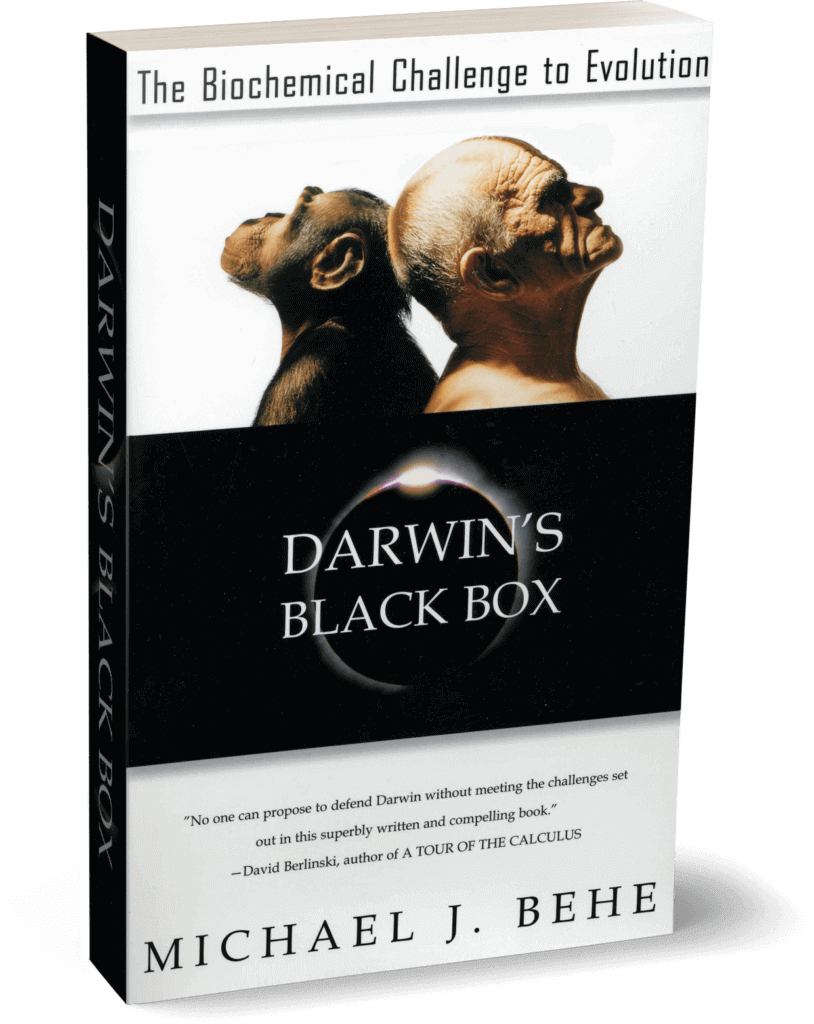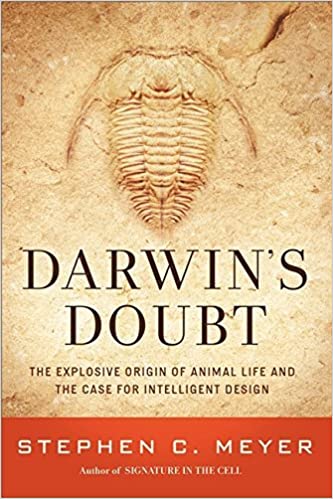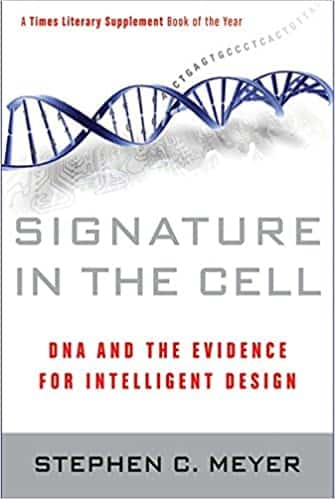“Evolution / Intelligent Design” Books
DARWIN’S BLACK BOX
Darwin’s Black Box helped to launch the Intelligent Design movement: the argument that nature exhibits evidence of design, beyond Darwinian randomness. Today, with the movement stronger than ever, Michael J. Behe updates the book with an important new Afterword on the state of the debate. (Time Magazine)
In Darwin’s Black Box, Michael Behe argues that evidence of evolution’s limits has been right under our noses, but its undoing is evident at such a small scale that we have only recently been able to see it. The field of biochemistry, begun when Watson and Crick discovered the double-helical shape of DNA, has unlocked the secrets of the cell. There, biochemists have unexpectedly discovered a world of Lilliputian complexity. As Behe engagingly demonstrates, using the examples of vision, bloodclotting, cellular transport, and more, the biochemical world comprises an arsenal of chemical machines, made up of finely calibrated, interdependent parts. For Darwinian evolution to be true, there must have been a series of mutations, each of which produced its own working machine, that led to the complexity we can now see. The more complex and interdependent each machine’s parts are shown to be, the harder it is to defend Darwin’s gradualistic paths. Behe surveys the professional science literature and shows that it is completely silent on the subject, stymied by the elegance of the foundation of life. Could it be that there is some greater force at work?
Behe believes in the scientific method and does not look to religious dogma for answers to these questions. But he argues persuasively that biochemical machines must have been “designed” — either by God, or by some other higher intelligence. For decades science has been frustrated, trying to reconcile the astonishing discoveries of modern biochemistry to a nineteenth-century theory that cannot accommodate them. With the publication of Darwin’s Black Box, it is time for scientists to allow themselves to consider exciting new possibilities, and for the rest of us to watch closely.
For this edition, Behe has written a major new Afterword tracing the state of the debate in the decade since it began. It is his first major new statement on the subject and will be welcomed by the thousands who wish to continue this intense debate.
Naming Darwin’s Black Box to the National Review’s list of the 100 most important nonfiction works of the twentieth century, George Gilder wrote that it “overthrows Darwin at the end of the twentieth century in the same way that quantum theory overthrew Newton at the beginning.” Discussing the book in The New Yorker in May 2005, H. Allen Orr said of Behe, “he is the most prominent of the small circle of scientists working on intelligent design, and his arguments are by far the best known.” From one end of the spectrum to the other, Darwin’s Black Box has established itself as the key text in the Intelligent Design movement—the one argument that must be addressed in order to determine whether Darwinian evolution is sufficient to explain life as we know it, or not.
Critique of neo-Darwinian thinking, Behe focuses on five phenomena: blood clotting; cilia, oar-like bundles of fibers; the human immune system; transport of materials within the cell; and the synthesis of nucleotides, building blocks of DNA. In each case, he finds systems that are irreducibly complex–no gradual, step-by-step, Darwinian route led to their creation. As an alternative explanation, Behe infers that complex biochemical systems (i.e., life) were designed by an intelligent agent, whether God, extraterrestrials or a universal force.

Read Online Famous Book “Darwin’s Black Box”
Download and Read Famous Book “Darwin’s Black Box” (10 Mbyte)
Another Download Famous Book “Darwin’s Black Box” (23 Mbyte)
A Response to Critics of Darwin’s Black Box
Darwin’s Doubt: The Explosive Origin of Animal Life and the Case for Intelligent Design
The book is divided into three main parts.
Part One, “The Mystery of the Missing Fossils,” describes the problem that first generated Darwin’s doubt
—the missing ancestors of the Cambrian animals in the earlier Precambrian fossil record—and then tells the story of the successive, but unsuccessful, attempts that biologists and paleontologists have made to resolve that mystery.
Part Two, “How to Build an Animal,” explains why the discovery of the importance of information to living systems has made the mystery of the Cambrian explosion more acute. Biologists now know that the Cambrian explosion not only represents an explosion of new animal form and structure but also an explosion of information—that it was, indeed, one of the most significant “information revolutions” in the history of life. Part Two examines the problem of explaining how the unguided mechanism of natural selection and random mutations could have produced the biological information necessary to build the Cambrian animal forms. This group of chapters explains why so many leading biologists now doubt the creative power of the neo-Darwinian mechanism and it presents four rigorous critiques of the mechanism based on recent biological research.
Part Three, “After Darwin, What?” evaluates more current evolutionary theories to see if any of them explain the origin of form and information more satisfactorily than standard neo-Darwinism does. Part Three also presents and assesses the theory of intelligent design as a possible solution to the Cambrian mystery. A concluding chapter discusses the implications of the debate about design in biology for the larger philosophical questions that animate human existence. As the story of the book unfolds, it will become apparent that a seemingly isolated anomaly that Darwin acknowledged almost in passing has grown to become illustrative of a fundamental problem for all of evolutionary biology: the problem of the origin of biological form and information.
Charles Darwin knew there was a significant event in the history of life that his theory did not explain. In what is known today as the “Cambrian explosion,” many animals suddenly appeared in the fossil record 530 million years ago without apparent ancestors in earlier layers of rock. In Darwin’s Doubt, Stephen C. Meyer tells the story of the mystery surrounding this explosion of animal life and makes a compelling case for the theory of intelligent design as the best explanation for the origin of the Cambrian animals and the biological information necessary to produce them.

Download and Read Famous Book of “Darwin’s Doubt: The Explosive Origin of Animal Life and the Case for Intelligent Design”
Darwin Devolves: The New Science About DNA That Challenges Evolution
The scientist who has been dubbed the “Father of Intelligent Design” and author of the groundbreaking book Darwin’s Black Box contends that recent scientific discoveries further disprove Darwinism and strengthen the case for an intelligent creator.
In his controversial bestseller Darwin’s Black Box, biochemist Michael Behe challenged Darwin’s theory of evolution, arguing that science itself has proven that intelligent design is a better explanation for the origin of life. In Darwin Devolves, Behe advances his argument, presenting new research that offers a startling reconsideration of how Darwin’s mechanism works, weakening the theory’s validity even more.
A system of natural selection acting on random mutation, evolution can help make something look and act differently. But evolution never creates something organically. Behe contends that Darwinism actually works by a process of devolution—damaging cells in DNA in order to create something new at the lowest biological levels. This is important, he makes clear, because it shows the Darwinian process cannot explain the creation of life itself. “A process that so easily tears down sophisticated machinery is not one which will build complex, functional systems,” he writes.
In addition to disputing the methodology of Darwinism and how it conflicts with the concept of creation, Behe reveals that what makes Intelligent Design unique—and right—is that it acknowledges causation. Evolution proposes that organisms living today are descended with modification from organisms that lived in the distant past. But Intelligent Design goes a step further asking, what caused such astounding changes to take place? What is the reason or mechanism for evolution? For Behe, this is what makes Intelligent Design so important.
Download and Read “Darwin Devolves: The New Science About DNA That Challenges Evolution”
Signature in the Cell: DNA and the Evidence for Intelligent Design
Named one of the top books of 2009 by the Times Literary Supplement (London), this controversial and compelling book from Dr. Stephen C. Meyer presents a convincing new case for intelligent design (ID), based on revolutionary discoveries in science and DNA. Along the way, Meyer argues that Charles Darwin’s theory of evolution as expounded in The Origin of Species did not, in fact, refute ID.

Download and Read “Signature in the Cell: DNA and the Evidence for Intelligent Design”
Read “Signature in the Cell: DNA and the Evidence for Intelligent Design”
See the video about Signature in the Cell
Debating Design (From Darwin to DNA)
The book includes the following subjects;
- Design without Designer: Darwin’s Greatest Discovery
- The Collapse of “Irreducible Complexity
- The Design Argument
- DNA by Design?
- Darwinism, Design, and Complex Systems Dynamics
- Darwin, Design, and Divine Providence
- The Inbuilt Potentiality of Creation
- Intelligent Design: Some Geological, Historical, and Theological Questions
- The Argument from Laws of Nature Reassessed
- The Logical Underpinnings of Intelligent Design
- Information, Entropy, and the Origin of Life
- Irreducible Complexity: Obstacle to Darwinian Evolution
- The Cambrian Information Explosion: Evidence for Intelligent Design,
- …
Download and Read Debating Design (From Darwin to DNA)
Icons of Evolution: Science or Myth? Why Much of What We Teach About Evolution Is Wrong
How would you react if told that you and your children have been lied to in science lessons at school and university? Yet this is exactly what has been happening for decades, as Icons of Evolution’ demonstrates.
The author, a Berkeley Ph.D in Biology, is not a creationist, but his book describes many serious misrepresentations of facts commonly found in biology textbooks, which are used to perpetuate belief in evolution. The main part of the book describes ten of these icons’, devoting one chapter to each, and shows what is wrong with them in the light of published scientific evidence.
“If the icons of evolution are supposed to be our best evidence for Darwin’s theory, and all of them are false or misleading, what does that tell us about the theory? Is it science, or myth?” (Icons of Evolution p. 8)
“[T]he icons of evolution have been advertised for years as the best evidence we have …
Many of these biologists believe in Darwinian evolution because that’s what they learned from their textbooks.” [p. 229]
“[D]ogmatic promoters of Darwinism did not see themselves as deceivers. Yet they seriously distorted the evidence – often knowingly. If this is fraud when a stock
promoter does it, what is it when a scientists does it?” [p. 234]
“This is one of the most important books ever written about the evolution controversy. It shows how devotion to the ideology of Darwinism has lead to textbooks which are full of misinformation.” (P.E. Johnson)
The Mystery of Life’s Origin
The origin of life from non-life remains one of the most enduring mysteries of modern science. The Mystery of Life’s Origin: The Continuing Controversy investigates how close scientists are to solving that mystery and explores what we are learning about the origin of life from current research in chemistry, physics, astrobiology, biochemistry, and more. The book includes an updated version of the classic text The Mystery of Life’s Origin by Charles Thaxton, Walter Bradley, and Roger Olsen, and new chapters on the current state of the debate by chemist James Tour, physicist Brian Miller, astronomer Guillermo Gonzalez, biologist Jonathan Wells, and philosopher of science Stephen C. Meyer.
the content of the book is as follows;
1. Crisis in the Chemistry of Origins
2. The Theory of Biochemical Evolution
3. Simulation of Prebiotic Monomer Synthesis
4. The Myth of the Prebiotic Soup
5. The Early Earth and Its Atmosphere
6. Plausibility and Investigator Interference
7. Thermodynamics of Living Systems
8. Thermodynamics and the Origin of Life
9. Specifying How Work Is to Be Done
10. Protocells
11. Summary and Conclusion
12. Epilogue
13. We’re Still Clueless about the Origin of Life
14. Thermodynamic Challenges to the Origin of Life
15. What Astrobiology Teaches about the Origin of Life
16. Textbooks Still Misrepresent the Origin of Life
17. Evidence of Intelligent Design in the Origin of Life
See contents and Chapter 14. Thermodynamic Challenges to the Origin of Life
SEE THE SERIES OF SECRETS OF CELL VIDEOS (DISCOVERY SCIENCE)
Secrets of the Cell with Michael Behe, Ep. 1
Discover the amazing world of micro-machines inside our cells.
The Complexity of Life (Secrets of the Cell with Michael Behe, Ep. 2)
Join bestselling author and biochemist Michael Behe as he explores “reducible” and “irreducible” complexity at the foundation of life of “Secrets of the Cell.”
Bugs with Gears (Secrets of the Cell with Michael Behe, Ep. 3)
Explore the amazing gears in insects and then investigate the power of evolution in episode 3 of “Secrets of the Cell” hosted by biochemist and bestselling author Michael Behe. When people invented gears is not certain, but examples survive in artifacts from ancient China and Greece. These indicate that the mechanism was known well over 2,000 years ago. Impressive!
The Effects of Mutation (Secrets of the Cell with Michael Behe, Ep. 4)
Biochemist and bestselling author Michael Behe explores the impact of mutations on evolution in Episode 4 of his series “Secrets of the Cell with Michael Behe.” Do random mutations and natural selection provide an explanation for the development of new organisms and features in the history of life?
The X Factor in Life (Secrets of the Cell with Michael Behe, Ep 5)
Biochemist and bestselling author Michael Behe explores the key missing factor in Darwinian explanations of the complexity of life in Episode 5 of his series “Secrets of the Cell with Michael Behe.” In this final episode, Behe gives a last consideration of the “X Factor” that appears to lie behind the wonderful, irreducible complexity of biology. That “X Factor,” he explains, is an intelligence inconceivably beyond our own.
ATP Synthase: The power plant of the cell
The Intelligent Design of Molecular Machines in the Cell: ATP Synthase is a molecular machine found in many living organisms. It serves as a miniature power-generator, producing an energy-carrying molecule, adenosine triphosphate, or ATP. The ATP synthase machine has many parts we recognize from human-designed technology, including a rotor, a stator, a camshaft or driveshaft, and other basic components of a rotary engine. This machine is just the final step in a long and complex metabolic pathway involving numerous enzymes and other molecules—all so the cell can produce ATP to power biochemical reactions, and provide energy for other molecular machines in the cell.
SEE OTHER VIDEOS ABOUT INTELLIGENT DESIGN AND EVOLUTION
Is Darwin’s Theory true or wrong?
Dr. Stephen Meyer and Dr. John Ankerberg explores DNA and Darwin’s theory of evolution.
Programming of Life
An exploration of microbiology, information science, and the origin of life.
The Molecular Basis of Life
DNA animations, Molecular Visualizations of DNA, Molecular Machines in the Living Cells
Kinetochore and Mitosis
Structure and dynamics of kinetochore and mitotic chromosome
UNLOCKING THE MYSTERY OF LIFE
UNLOCKING THE MYSTERY OF LIFE is based upon the scholarly work of Stephen C. Meyer, Michael Behe, William Dembski and others. This documentary film presents a powerful but controversial idea—the theory of intelligent design. The scientific case for intelligent design is based upon recent discoveries in biochemistry, genetics, and molecular biology, highlighted by computer animation that depicts the inner-workings of the living cell.
Richard Dawkins Proves Intelligent Design in 5 Min
Darwinian evolution’s champion Richard Dawkins (Famous Atheist) logically proves intelligent design. Richard Dawkins proves intelligent design by confirming the premises of the DNA argument for intelligent design as formulated by Stephen C. Meyer, thereby showing in spite of himself how to arrive at the conclusion of intelligent design using elementary logic and facts of science.
Amazing Flagellum : Michael Behe and the Revolution of Intelligent Design
The bacterial flagellum has become an iconic example of the evidence against modern Darwinian theory as well as the evidence for intelligent design. Stephen Meyer, Scott Minnich and others scientists and scholars explore the facts about this amazing piece of nanotechnology, first made famous by biologist Michael Behe when he coined the phrase irreducible complexity.
Information Enigma: Where does information come from?
Information drives the development of life. But what is the source of that information? Could it have been produced by an unguided Darwinian process? Or did it require intelligent design? The Information Enigma is a fascinating 21-minute documentary that probes the mystery of biological information, the challenge it poses to orthodox Darwinian theory, and the reason it points to intelligent design. The video features Dr. Stephen Meyer, and molecular biologist Douglas Axe, founder of the Biologic Institute.
Origin: Probability of a Single Protein Forming by Chance
This clip is an excerpt from the film ORIGIN: Design, Chance and the First Life on Earth.
Probability of a Single Cell Forming by Chance
This clip is an excerpt from the film Programming of Life (see above).